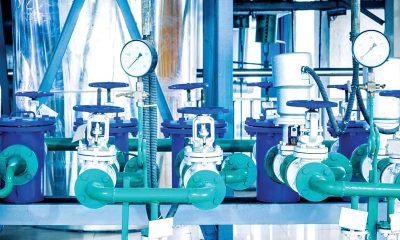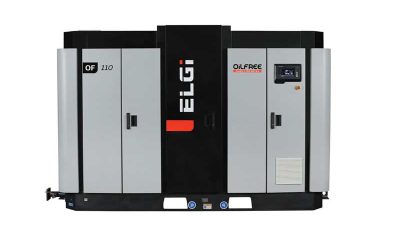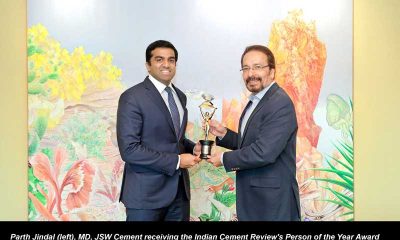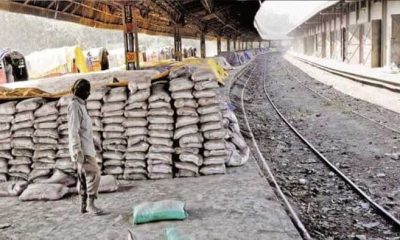Technology
Technology trends in cement manufacturing
Published
6 years agoon
By
admin
– Dr Anjan K Chattejee
What have been the visible technological advancements in cement manufacturing during the last decade?
The cement industry in the world has grown phenomenally in the last decade and the production level of all varieties of Portland cements taken together has crossed four billion tonnes, which is the largest volume amongst all manmade materials. Such growth has been possible due to considerable advances made in the hardware and software of cement manufacture. The main drivers for these technological advances have so far been the ‘cost’ and ‘quality’ of products. The technological progress has been multi-dimensional as reflected in the following features:
1. The capacity of a single kiln for clinker making has reached 12,000-13,000 tonne (t) per day, although in the recent years there is a trend of installing kilns of lower capacity due to economic and logistics reasons.
2. With automation, instrumentation, computer-aided controls and integration of expert systems the man-hours per tonne of cement came down to one or even less, thereby reducing the application of human discretion and increasing the dependence on electronic gadgets.
3. The choice of grinding systems for raw material and clinker has been dependent on the better energy utilisation factor, which has led to more extensive adoption of vertical roller mills, high-pressure roll presses and horizontal roller mills.
4. The fourth generation clinker coolers are now available from several suppliers, operating with 75 per cent efficiency of the theoretical maximum.
5. Significant developments have taken place in multi-channel burners, which have been specifically designed for co-incineration of alternative fuels.
6. The efficiency of the thermal process inclusive of raw materials drying has now touched almost 80 per cent of the theoretical maximum.
7. Driven by the rising prices of power and fuel, experiencing concerns about grid reliability, and fulfilling the commitments to sustainable development, the cement industry has taken more interest in ‘waste heat recovery’. While the most common water-steam cycles operate at heat source temperatures as low as 3000C, for heat recovery from still lower temperatures, the Organic Rankin Cycle, utilising organic compounds as process flows or the Kalina Cycle, using a water-ammonia solution, are now available for implementation in cement plants.
8. For sustainable production, the AFR use has taken deep root in the operational philosophy. Depending on the social conditions, living habits, availability of AFR and its collection systems, the extent of use varies from country to country, although the objective is to maximise its use.
9. Process measures and secondary abatement technologies ensure low emissions of dust, NOx and SOx in all modern plants. Recently additional focus has been laid on emissions of mercury and carbon dioxide. In parallel, there has been significant progress in developing continuous emission monitoring systems.
10. There has been widespread application of computational fluid dynamics (CFD) and of physical simulation and modelling in solving process and design problems.What are your observations on the progress achieved in reducing the energy consumption in manufacturing?
The global average thermal and electrical energy consumption levels are reportedly 800-850 kcal/kg of clinker and 100-110 kWh/t of cement. Compared to these levels the average specific energy consumption values in India are 725 kcal/kg clinker and 82 kWh/t cement and the corresponding best values obtained are 667 kcal/kg and 68 kWh/t. From these values it appears that globally there is still enough scope for better energy management, while in India the potential of energy conservation is rather limited.
In this context, it is important to note that more rigorous environmental norms will, of course, reduce the emission loads but at the cost of energy. Further, stricter specifications of products, more stringent control of particle size requirements, use of non-carbonate alternative materials, etc. are expected to integrate new or additional process measures, which might increase the energy consumption. Hence, the potential of further energy conservation in our country in particular will depend on the future course of product quality and environmental demands. In addition, the limitations of plant vintage, design and layout may act as obstacles in achieving further energy conservation.Are you satisfied with the research done on low- and off-grade limestone?
While the use of low- or off-grade limestone is not a critical concern in many countries, it is certainly an issue that needs to be dealt with more seriously in our country, as it can create 25-30 per cent additional resource base for the rapidly expanding industry. Limestone having CaO content of less than 42 per cent and limestone containing impurities of high silica or high magnesia or high iron content fall in this category and viable technologies for their use will be of immense economic benefit. Researches in this field, however, are sporadic and academic. The current technologies are limited to ‘sweetening’, wobbling, belt sorting, and froth flotation.
The newer technological options of photometric sorting, electrostatic separation, bioleaching, or making products not conforming to the conventional types, continue to be exploratory in their development. On the contrary, utilisation of marginal grade limestone by the cement industry deserves a ‘mission’ status in our country. Since dry manufacturing systems can these days co-exist with wet preparation of raw materials, improved froth flotation and bioleaching techniques cannot be ignored.
More logical perhaps is to look at new products and new processes, High-belite cement and high-magnesia blended cement are examples of such possibilities. Use of dolomitic limestone for simultaneous manufacture of cement and magnesia is a technology worth re-examining. Broadly speaking, it is time to lay much greater emphasis on research on utilising low-grade limestone.What is the status of research for enhancing the use of high-ash coal?
We all know that the cement industry has been a very effective user of high-ash coal. The kiln burners are designed suitably to combust high-ash coal and the plants make use of coal with ash content of 35-40 per cent in most cases. Mixing of coal with varying ash contents has also been in practice to facilitate the use of high-ash coal. Several attempts were made in the past to install small captive coal washing units in a few cement plants to upgrade the quality of coal for process consumption but not with success due to economic and operational reasons. A few pit-head coal washing plants are operating in the country to de-ash non-coking coal prior to supply to the cement units and other users. The aforesaid measures do not seem to be adequate to meet the future demand of clean coal. Hence, for enhancing the use of high-ash coal further it would be important to integrate the technology of coal gasification with the cement manufacturing process.
Technologies for coal gasification are decades old but their integration with the cement manufacturing process needs specific development with regard to the operational features and economic viability. It is pertinent to mention here that coal gasification is attractive from the economic and energy security perspectives but the overall carbon intensity is much higher than coal mining. The technology is also water-intensive. Nevertheless, the abundantly available resource of high-ash coal in the country needs to be considered an object of priority in meeting the energy demand by adopting such a technology. It is interesting to note that China has laid out plans to produce 50 billion cubic metres of gas from coal by 2020, enough to satisfy more than 20 per cent of total gas demand. Despite the stated environmental shortfalls, the technology has been introduced in order to exploit the stranded coal deposits sitting thousands of kilometres away from the main industrial consuming centres, as transportation of gas is deemed cheaper than transporting solid fuel. It might also be pertinent to mention here that in some countries the adverse environmental problems of gasification technology has led to considering the alternative ‘underground coal gasification’ process.
In brief, the process involves pumping oxygen and steam through a small borehole into the coal seam to cause local combustion. The synthetic gas product consisting of hydrogen, methane, carbon monoxide and carbon dioxide is siphoned off through a second borehole and is collected, transported, stored and used. It is reported that the underground coal gasification process substantially reduces the CO2 emission.
While on the subject, another widely known clean coal technology of ‘coal bed methane’ deserves a mention. The process is relevant for coal deposits that are too deep to mine. Water is sucked out of the seam and methane attached to the surface of the coal seam is freed and then collected. The CBM technology is said to have fundamentally changed the dynamics of the gas industry in Australia.
Considering the plethora of options for clean coal technology, it is important for the cement industry to be more involved in coal research but in a co-ordinated national strategy, as it cannot be handled at the individual company level.What is the progress in real-time analysis for QC in cement plants?
Recent developments in the use of x-ray diffraction are changing the traditional methods of quality and process control, as they have the ability to measure mineral phases or compounds formed directly in real time. Cement and clinker production involves chemical reactions to produce precisely controlled blends of phases with specific properties. So far there has been overwhelming dependence on either off-line or on-line oxide or elemental analysis of raw or in-process materials for QC.
Methods and equipment are now available for continuous quantitative on-stream analysis of the mineral or phase composition of cement and clinker. The instrument is a stand-alone piece of equipment, which is installed at the sampling point. A sample for analysis is extracted from the process stream and after due preparation on-line the sample passes through the x-ray beam.
The diffracted x-rays are collected over 0 to 1200 by a detector. The Rietveld structural refinement technique is applied to analyse the resulting diffraction pattern. The analysis of the moving stream is done in close frequency of, say, once every minute. All analysis results are communicated directly to the plant PLC system. The real-time measurement of the mineral composition of cement and clinker for process control is a paradigm shift for the cement industry. The discernible benefits of using on-stream x-ray diffraction are the following:
- Control of kiln burner based on free lime, clinker reactivity, alkali and sulphur contents
- Control of cement mill separators and feed rates and proportions to achieve consistent cement strength at minimum power consumption
- Control of gypsum dehydration through cement mill temperature to give consistent setting times
- Control of mill weigh-feeders for different feed materials.
The net advantages of implementation of such on-line QC systems are the optimum performance and cost, reduced risk of product failure and consequent marketing benefits.
Another development in the on-stream analysis, apart from the widely used bulk analyser based on Y-radiation, is the application of infrared spectra that are provided by the stabilised white light source. The light illuminates the target bulk material to be analysed as it passes the unit on an existing conveyor belt. The infrared radiation excites vibrational oscillations of the molecular bonds in the material under test, which results in reflection and absorption spectra that are characteristic of minerals being analysed.
The Near Infrared (NIR) ranges are applied for analysing limestone materials. It is claimed that the IR based on-line bulk analyser shows better performance for the cement raw material constituents than the traditional Y-ray equipment. One additional advantage in this new development is the avoidance of potentially hazardous excitation sources.What would you like to highlight as significant technological steps in pyro-processing?
Over and above the standard features of a large-capacity modern 5/6 stage preheater kiln with precalciner at one end and efficient clinker cooler at the other, a specific mention may be made of the advent of two-support kiln systems. Compared with the traditional three-support kilns, the two-support kilns offers the following advantages: saving of space, reduced kiln surface heat loss, lower machine weight and less foundation requirements, elimination of kiln girth gear and reduced number of supporting rollers, lower risks of kiln shell ovality and misalignment of kilns. Hence, the general acceptance of two-support kilns is likely to increase.
The second notable development is the introduction of low-NOx burners, based on the principle of staged combustion. Further, the preheater-precalciner system can now be tailored to suit the primary and secondary fuels used for burning operation. It is possible to install low-NOx calciner with longer residence time, calciner with ignition module for ignition in pure air, or calciner with an integrated chamber for ignition of fuel in pure air at high temperature. It is also possible to introduce in the system a specially designed combustion chamber, such as the ‘Hotdisc’ of FLS, for alternative difficult-to-burn lumpy fuels.
The third important development is the secondary abatement technology for NOx with selective non-catalytic reduction. We also see more efficient on-line systems for SOx abatement. Similarly, secondary abatement systems for VOC will find application, where necessary.Which are the technological developments of significance in the grinding process?
For the comminution equipment the development of construction materials with high wear resistance is of great significance. In roller mills, where there are contradictory demands of both ductility and hardness, the new materials provide longer life with reduced maintenance. An example of the new material is the double casting for roller tyres, in which high-chromium alloy inserts or bars are incorporated into a ductile iron base. The second example is a metal matrix composite in which the high-chromium alloy is reinforced with ceramic particles. The layer of ceramic particles is evenly distributed over the surface in a honeycomb pattern.
The surfaces of roll presses are also vulnerable to damage and hence, like the VRMs, the main aim of continued design development for roll presses has been to achieve higher operational reliability of the surfaces. Using wearing parts of chilled cast material, or the composite material build-up with buffer layers with a wear-resistant top layer, or fabrication of two-piece grinding rolls consisting of a shaft with shrunk-on tyre with welded hard layer as armour are some of the illustrations of these developments.
In addition to the material development for the mill systems, the progress in the commercialisation of ‘horomills’ is worth noting. More than 50 industrial references are now available globally. The tentative single mill capacity for raw meal and normal Portland cement ranges up to 180 t/h and 425 t/h respectively. Two mills installed together can raise the corresponding output levels to 680 t/h and 280 t/h.
The horomill covers the same application fields as conventional ball mill, VRMs and roll presses and the industrial operations have shown energy savings ranging from 35per cent to 60 per cent. Since the horomills have compact integrated drives like those of ball mills, it is comparatively easy to install within a limited space. The system includes auxiliary equipment such as the classifier, filter and bucket elevator. One of the advantages of a horomill seems to be its production flexibility, thanks to the small quantity of material in grinding and separating circuit.What are your observations on the present trends of process control and
‘expert systems’?
The control systems in the modern plants consist of human-machine interfaces, control software, and programmable logic controllers. They include data packages that can bring out trends of control parameters, alarm provisions and even log
details of shift operators. These packages have large flexibilities to change the graphics and control logic and the unit processes are controlled from a central control room.
The process instrumentation has expanded considerably and computer models are used to operate complex processes. Fuzzy-type or rules-based logic gained wide popularity in the 1990s and its use is continuing more extensively. Kiln optimisation and mill control are all predominantly based on rules-based fuzzy. However, after being on the fringe for many years, the latest versions of neural net technology and model-based predictive techniques are coming to the fore as competitive options.
The expert packages such as ABB Expert Optimiser/Linkman with logical dynamic modelling tools, FLS Automation ECS/ProcessExpert integrating camera signals and soft sensors, Pavillion8 MPC, Powitec PIT Indicator/Navigator. Lafarge LUCIE, Polexpert KCE/MCE are some of the advanced systems in the market. The ramp-up in the market for expert systems in future would depend more and more on integration with high-quality soft sensors of in-process materials, camera signals, on-line particle-size analysers, etc. Further, many supervisors and laboratory managers have started making use of remote access software to communicate and to provide assistance to the plant.
The next phase of control strategies seems to be heading towards intelligent field devices that use self-diagnostics and can electronically communicate specific instructions to the maintenance set-up of the plant. There is no doubt that technologically the plant control systems are progressing quite rapidly and are turning out to be more sophisticated.Do you foresee any disruptive technology coming to the cement industry?
Disruptive technologies can come from researches in two directions – one, developing new manufacturing processes for Portland cement and, another, new cement that is generically different from Portland cement. As far as the manufacturing process is concerned, the rotary kiln technology has become deep-rooted in practice and created a firm position for itself with preheater-precalciner subsystems for large-scale Portland clinker production.
Several alternative processes have been attempted during the last four decades, which include vertical shaft kilns, fluidised-bed process, conveyor kilns, microwave heating, radiation synthesis, sol-gel process, melting and quenching and a few other options. Excepting the vertical shaft kiln technology and the fluidised-bed process, all other routes for clinker making have remained in the realm of academic research. Industrialisation of the vertical shaft kiln technology flourished in some countries but ultimately it lost ground to the rotary kiln technology in respect of viability and scale of operation.
Similarly, the fluidised-bed process has been used for small capacity plants; engineering designs have been prepared up to 3000 t/d capacity, but its competitiveness with large-scale clinker making in rotary kilns could not be established so far. Hence, in manufacturing terms, no disruptive technologies can at present be forecast.
For alternative binders the research has been continuing almost since the Portland cement was born. The persistent research efforts led to the invention of three new generic cements, viz., calcium aluminate cement, calcium sulfo-aluminate-belite cement, and alinite cement. All the three binders have certain merits that are not found in Portland cements but they have certain serious shortcomings, which prevent them to qualify as alternatives to Portland cements.
Calcium aluminate cement shows retrogression of strength at higher temperatures, calcium sulfo-aluminate cement requires high-cost raw materials and alinite cement has the strong probability of releasing chlorine during hydration. All these binders are good for niche applications and not for substituting Portland cements as all-purpose structural cements.
Hydraulic cements based on magnesium oxide have recently been claimed to offer great potential for reducing CO2 emission. These binders are in the process of development and use either magnesium carbonate or magnesium silicate as the raw material. It seems that this direction of development has considerable potential for scaling up and commercialisation. There has also been a considerable research on the manufacture of cement and concrete by carbonation instead of hydration.
One trend of development in this category uses either seawater or brine as raw material and another direction is to synthesise a low-calcium silicate clinker. In both the research directions the objective is to recycle CO2 from the captured flue gases for carbonation. The global effectiveness of this approach will depend on the extent to which a circular economy for CO2 develops. The environmental compulsions for CO2 recycling with value addition cannot be ignored, particularly in view of the fact that the known approach of CO2 capture and sequestration is unviable for the cement manufacturing process.
Looking at the overall scenario of product development, one may arrive at the conclusion that no disruption in Portland cement manufacture is predicted as of now. Hence, the production of blended cements with supplementary cementing materials will continue globally. Some niche markets will be served by the new binders and, more particularly, by the belite-rich Portland cement, calcium sulfo-aluminate cement, calcium aluminate formulations, alinite cement, and carbonated binders and concrete. The emergence of magnesia-based cements should not be lost sight of in this melee.Dr Anjan K Chattejee is an international personality in cement, and is presently associated with development of LC3 cement and advisor to Pidilite industries. He is Former Wholetime Director of ACC Ltd, Mumbai and Chairman, Conmat Technologies Pvt Ltd, Kolkata.
You may like
Economy & Market
We are shaping the future of clean air
Published
4 days agoon
April 16, 2024By
admin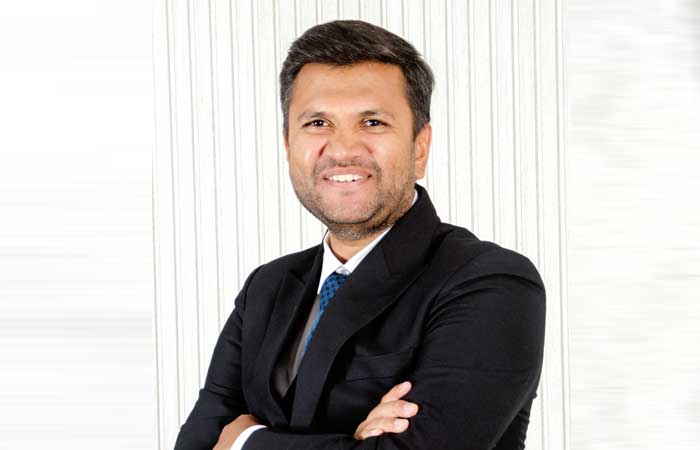
Monil Parikh, Managing Director, Techflow Enterprises Pvt Ltd, leads us to a better understanding of how cutting-edge designs and advanced technologies are revolutionising the process of filtration, driving efficiency and environmental responsibility within the cement sector.
Tell us about your air pollution control systems.
Techflow Enterprises, operating from our expansive 30,000 sq m facility, which is one of India’s largest, manufactures a comprehensive suite of air pollution control systems specifically designed for cement plants. Our solutions include:
Pulse Jet Bag Filters: Employing compressed air for efficient cleaning, these capture fine dust particles generated during grinding and packing. Techflow’s bag filters are designed to restrict the outlet emission up to 5mg/Nm3.
Electrostatic Precipitators (ESPs): Ideal for ultra-fine particulate matter in kiln exhaust gases, ESPs utilise an electric field for superior dust capture with 99.9 per cent capacity.
Centrifugal Fans: We offer various fans like induced draft (ID) fans for draft creation, process fans for dust-laden air transport, and kiln fans for high-temperature gas streams.
Techflow’s commitment to quality is evident in our proven track record. We are actively supplying solutions to leading cement players like Adani Cements, Ambuja and ACC Cement, Dalmia Bharat Cement and Wonder Cement. Our installations across India and Asia stand as a testament to our expertise in handling cement plant dust control challenges.
How do your products and systems integrate with cement plants?
Techflow’s air pollution control systems seamlessly integrate into your existing cement plant. Our pulse jet bag filters fit effortlessly downstream of grinding mills and packing stations, effectively capturing fine dust particles generated during these processes. Electrostatic Precipitators (ESPs) excel in kiln exit gas streams, working alongside existing cyclones to achieve ultra-fine particulate control, a critical step in maintaining clean air emissions.
Techflow’s comprehensive offering of centrifugal fans ensures a perfect fit for any application. Our ID fans seamlessly integrate into the kiln system, creating the necessary draft to pull exhaust gases through the air pollution control equipment. Process fans, strategically placed throughout the plant, efficiently convey dust-laden air from various generation points, like clinker coolers and raw material handling, towards the filtration units. This modular approach minimises disruption during installation and ensures optimal dust collection across your entire cement production process.
How do your innovative designs better the process of filtration at cement plants bringing efficiency to the process?
Techflow’s commitment to innovation translates to superior filtration efficiency and operational cost savings for cement plants. Our pulse jet bag filters incorporate features like:
- High-efficiency filter media: Designed for specific dust types, this media minimises pressure drop across the filter, reducing energy consumption.
- Improved flue gas entry design
- Low Pressure Cleaning Systems
- Optimised pulse cleaning systems: These systems efficiently dislodge dust cake buildup using compressed air, maximising filter media life, and minimising downtime.
Our ESPs utilise advanced electrode designs to enhance particle collection and reduce maintenance intervals. Furthermore, Techflow’s centrifugal fans are meticulously crafted for superior aerodynamic performance, leading to lower energy consumption and improved overall plant efficiency.
Techflow has developed a SMART-LINK automation module for better maintenance and real-time remote tracking of performance of each equipment. Cement plants equipped with Techflow’s systems experience reduced operational costs, minimised downtime and compliance with ever-evolving environmental regulations.
What is the key differentiator between traditional filters and modern filters?
Traditional bag filter systems often relied on manual cleaning methods, leading to inconsistent performance, increased downtime, and potential worker exposure to dust. Modern pulse jet bag filters, like those offered by Techflow, address these limitations.
Our systems leverage automated cleaning mechanisms, ensuring consistent filtration efficiency and minimal operator intervention. Additionally, advanced filter media materials in Techflow’s bag filters offer superior dust capture capabilities compared to traditional fabric filters.
This commitment to modern technology translates to a safer and more efficient and environmentally friendly dust control solution for cement plants.
Can your designs be customised as per the requirement of the customers?
At Techflow, we understand that every cement plant has unique dust control requirements. That is why we prioritise customisation across our entire product range:
Pulse Jet Bag Filters: Filter media type and micron rating based on dust properties, number of filter bags, and pulse cleaning system configuration like cycle time and pressure can all be adjusted to optimise performance for your specific dust and airflow. The system can be designed to achieve less than 5mg/Nm3 outlet emission standards as well.
- Electrostatic Precipitators (ESP): ESP design can be customised with features like the number of electrode rows, electrode spacing, and power input like voltage and current to achieve the desired dust collection efficiency for your specific outlet emission capacity less than 20mg/Nm3.
- Centrifugal Fans: Fan designs are tailored by adjusting factors like impeller diameter, blade design, and motor size to meet the specific pressure and flow requirements of various processes within a cement plant.
This focus on customisation ensures Techflow’s air pollution control systems perfectly match your cement plant’s needs, guaranteeing optimal dust capture and efficient operation.
What is the role of technology and automation in building filtration systems?
Techflow has designed a SMART-LINK System that can be integrated to our equipment which tracks and monitors performance of equipment in real time.
- Continuous diagnostics
- Condition-based maintenance
- Prevention of unplanned downtime
- Early problem detection using AI
- Data collection for process optimisation and efficiency maximisation
- Auto alert with warning driving timely human interactions
- Remote maintenance assistance by Techflow Team.
What are the major challenges in the filtration process and your system integration at cement plants?
The cement industry’s focus on sustainability, higher production and diverse fuel sources creates filtration hurdles. Adapting to changing dust properties, handling increased dust loads, and integrating seamlessly within space constraints are key challenges.
Techflow tackles these issues through advanced design techniques, exploration of innovative filter media, and modular system design. This ensures our filtration systems remain adaptable, efficient and seamlessly integrated within your cement plant, empowering your success.
How do you plan to further better your products and bring innovation in the future?
At Techflow, we are not just building filtration systems, we are shaping the future of clean air in the Indian cement industry. After successful expansion of the manufacturing facility in 2023, now it is time to improve designs and process optimisation. The future holds exciting possibilities: next-generation filter media with self-cleaning properties and
extended lifespans, minimising maintenance and maximising efficiency.
Techflow’s legendary after-sales support is about to get even better. We are expanding our global service network to provide you with 24/7 access to a team of India’s most experienced filtration specialists, ensuring your system operates flawlessly throughout its lifecycle.
Together, we will lead the way towards a sustainable future, paving the path for a greener tomorrow with green cement.
- –Kanika Mathur
Economy & Market
Digitalisation is changing the logistics landscape
Published
4 days agoon
April 16, 2024By
admin
Haresh Calcuttawala, CEO and Co-Founder, Trezix, explains how their platform streamlines export processes, optimises logistics operations, and addresses the challenges faced by the cement industry.
How does your platform help in the compliance of cement exports?
The Trezix platform helps with the end-to-end processes for exporters, ensuring complete visibility of these processes focusing on shipments, documents, compliances, etc. The platform is also integrated with various stakeholders’ part of the export process including integration with Unified Logistics Integration Platform (ULIP) by the Government of India.
What is the impact of your systems on the cost and productivity of a cement plant?
The Trezix platform helps to optimise the turnaround time, visibility of shipment and improving efficiencies, which results in optimisation in logistics cost and improvement in working capital.
What are the major challenges in logistics and how can that be resolved?
A major challenge in the cement industry is the logistics cost and time for delivery. This can only be resolved with faster turnaround time, complete visibility of shipments, delivery lead time and process control to adhere to compliance.
Tell us your views on the change technology is bringing to logistics.
In the cement industry, so far technology has been more focused on internal process, and optimising demand and supply in the area of supply chain. However, now the focus has completely shifted to external stakeholders and their processes, and how have we integrated processes to further optimise the logistics execution.
Can your systems and solutions be customised based on customer requirements?
Every customer has some unique value proposition for their customer segment. Trezix has flexibility by way of configuration to adhere to industry needs and specific customer needs, keeping in mind the regulatory processes are not deviated to fulfil statutory requirements.
How do you foresee the face of logistics changing for the cement industry?
Digitalisation is one of the biggest waves you can see in the logistics space, which is changing the face of the industry. Digitalisation is changing the logistics landscape. Various concepts like Just In Time (JIT) to customer delivery are now a reality. Vehicle utilisation, fuel efficiency, delivery visibility, vehicle tracking through RFID, Fastag, FOIS (rail receipt tracking), container/cargo tracking across geography is now a reality.
- –Kanika Mathur

Ankit Kumar, Co-Founder and CEO, Skye Air, highlights the advantages of drone deliveries for the cement industry to improve the overall operational efficiency and cost-effectiveness of the supply chain.
What is the environmental impact that drone deliveries can create?
Drone deliveries have the potential to significantly reduce environmental impact compared to conventional delivery methods. By utilising drones, the carbon footprint of last-mile delivery can be slashed by eliminating the need for vehicles and vans, which emit greenhouse gases during transport. In fact, studies have shown that drone deliveries can reduce carbon emissions by up to 80 per cent compared to traditional delivery methods. Additionally, drones provide more direct routes, minimising congestion and further lowering emissions.
Furthermore, Skye Air’s implementation of drone technology can contribute to a substantial decrease in air pollution. Traditional delivery vehicles, powered by fossil fuels, contribute significantly to air pollution, whereas drones operate on cleaner energy sources, such as electricity. As a result, the adoption of drone technology by Skye Air could lead to a notable reduction in harmful pollutants released into the atmosphere.
It’s worth noting that Skye Air is committed to continuous monitoring and optimisation of its operations to ensure that the environmental benefits of drone delivery are maximised. Through data-driven analysis and innovative strategies, Skye Air aims to further enhance the efficiency and sustainability of its drone delivery services.
In conclusion, while drone deliveries offer significant environmental benefits, rigorous management and innovation are essential to mitigate any potential negative effects and ensure the long-term viability of drone delivery operations.
Tell us about the efficiency created by drone delivery systems.
Skye Air has spearheaded a paradigm shift in the logistics industry by substantially augmenting efficiency in their drone deliveries. Drones can help circumvent traditional road networks, bypass traffic congestion and surmount logistical impediments, facilitating expeditious and direct transportation of goods. This heightened efficiency is particularly conspicuous in exigent circumstances, such as the delivery of medical supplies to remote regions or the expeditious fulfillment of urgent orders. By harnessing the capabilities of drones, Skye Air optimises delivery routes, curtails fuel consumption, and mitigates the overall operational costs inherent in conventional delivery methodologies.
Indeed, empirical data underscores the efficacy of drone deliveries, showcasing a significant reduction in delivery times by up to 50 per cent compared to traditional methods. Moreover, drone deliveries have been shown to minimise fuel usage by approximately 60 per cent, contributing to substantial environmental conservation efforts.
Furthermore, the automation of the delivery process not only expedites operations but also bolsters efficiency, resulting in enhanced customer satisfaction rates. With streamlined processes and expedited turnaround times, Skye Air sets a new standard for excellence in the logistics domain.
What is the role of digitalisation and technology in your delivery and transport system?
In Skye Air, digitalisation and technology serve as pivotal catalysts in revolutionising our delivery and transport system. Through the integration of cutting-edge drone technology like Skye UTM, we have established a streamlined and efficient delivery process. Our drones are equipped with state-of-the-art navigation systems and sensors, enabling precise and secure delivery routes. Skye UTM stands as the most advanced and indigenised Aerial Traffic Management platform, designed to furnish situational awareness, autonomous navigation, risk assessment, and traffic management to all drone and aerial mobility operators across the airspace. Skye UTM has already facilitated successful BVLOS (Beyond Visual Line of Sight) drone flights. The Skye UTM captures over 255+ parameters of UAV movements, storing them in its ‘Black box’, which comprises a published systematic description of the entire flight. This platform offers the inaugural 3-Dimensional view of the drone airspace, alongside operations and regulations mapping servers, furnishing the latest airspace status, verified paths, and exhibiting real-time UAV movements. Furthermore, our digital platforms empower customers to seamlessly place orders and track their deliveries in real-time. This digitalisation not only amplifies the velocity and precision of our deliveries but also ensures transparency and accountability throughout the entire process.
Can drone deliveries be incorporated with the cement industry in the future?
In the foreseeable future, the incorporation of drone deliveries holds promise for integration within the cement industry, presenting efficient and swift transportation solutions for materials. The sophisticated drone technology prevalent in logistics stands poised to collaborate seamlessly with cement companies, optimising their supply chain operations. Drones can ferry small batches of cement or other construction materials to remote or challenging-to-access locations, thereby diminishing reliance on conventional transportation modes such as trucks and mitigating logistical complexities. Through the strategic utilisation of drones, the cement industry stands to bolster its efficiency, curtail costs and elevate overall operational efficacy.
- –Kanika Mathur

RAHSTA to showcase cutting-edge road construction tech, says NCC Director

RAHSTA will drive road construction innovation: Sundaresan

New appointment at TMEIC

Social Impact Award for Ambuja Cements

UCWL unveils new plant in Dabok, Udaipur

Environment Ministry revises rules of solid waste management

M-sand boards new terrain

Process and quality optimization in cement plant.
Concrete: A Highly Sustainable Building Material






